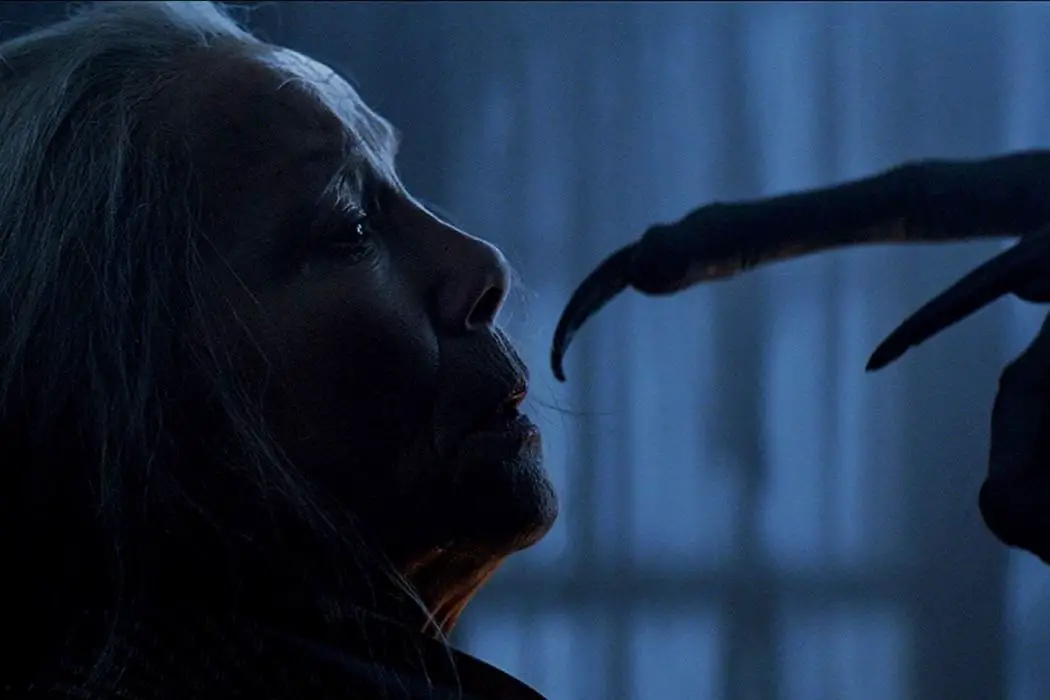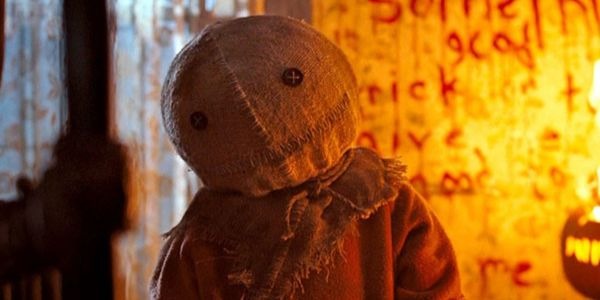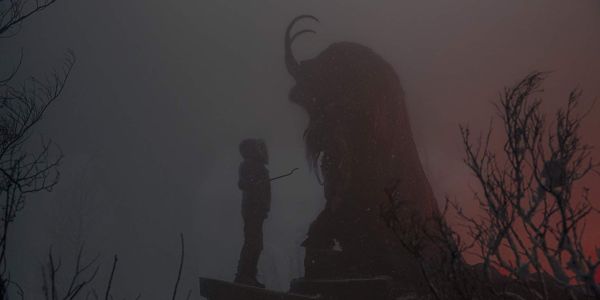How The Horror Films of Michael Dougherty Subvert Christianity

Danny Anderson teaches English at Mount Aloysius College in PA.…
Godzilla: King of Monsters, the latest installment of Legendary Entertainment’s “MonsterVerse” franchise, is in the wind-down phase of its theatrical release, to a fairly mixed critical response. Now that the buzz has subsided, it’s a good time to reflect on one distinct feature of the growing body of horror films by the movie’s director, Michael Dougherty.
As a franchise about monsters rising from an ancient slumber to threaten humanity, the Godzilla films fit into a broader category of “cosmic horror.” Usually associated with H.P. Lovecraft and his Cthulhu Mythos, this genre of horror is notable for the way in which it reduces human civilization to an insignificant blip when measured against the ancient gods of a pre-human past. When confronted with these elder gods, humanity must confront its meaningless insignificance.

Michael Dougherty has established himself as an ideal director of such a film.
A fact of cosmic horror is that in making humanity meaningless, it also renders our religious traditions moot and this has major ramifications for horror films, which, in general, assume a Christian metaphysical universe. If your film is about Satan (say The Exorcist) then God is implied to be lurking somewhere, no matter how badly the film treats him/her/it. Whatever happens on screen, it’s still His universe.
One narrative feature that makes horror films effective is the viewer’s concern for the main characters, whom we consider important. This is another way in which horror usually organizes itself around Christian ideas. No matter how literally a Christian reads Genesis, the idea is that creation was made for us and that we are somehow special. The existence of Cthulhu or Godzilla mocks this notion.
Dougherty has begun to carve out a niche for himself as a director of films that obliterate Christian metaphysics in horror, and Godzilla: King of Monsters is a natural fit for his distinct sensibilities.
Trick ‘r’ Treat (2007)
Trick ‘r’ Treat is one of those films that slipped under the radar upon its release, then built an enthusiastic cult following in the subsequent years (its central character, the childlike, vicious “Sam” is even a staple of horror costumes shops now). Clocking in at under 90 minutes and constructed as a series of inter-connected short stories, the film does quite a lot with its short running time. The stories invoke several classic horror figures, such as serial killers, vampires, ghosts, and werewolves, and crafts them into comedic horror vignettes of retribution and death.

One of the things that makes the film really interesting is how it takes these traditional tales and re-organizes them. Typically these figures are horrific because they are enemies of some form of Christian order. What Trick ‘r’ Treat does with them, however, is organize them around the pagan rite of Samhain. Here they are not really even villains, but functionaries of religious order that doesn’t even recognize Christianity.
Serial Killer or Vampire
Of all the Creatures of the Night, the Vampire has probably been most closely associated with Christianity. Going back to “the blood is the life” and moving forward, the pre-eminent movie monster has typically represented a direct inversion of Christian themes (Dracula 2000 goes so far with this approach that it frames the Prince of Darkness as Judas Iscariot himself). In effect, the vampire has largely represented a Christian order in reverse in cinematic horror.
Trick ‘r’ Treat aggressively subverts that trope. Here, the vampire is a false identity of the local serial killer/school principal, Steven (Dylan Baker). First appearing as a mysterious cloaked figure who murders a young woman in the midst of a debaucherous Halloween parade, he is later revealed to be a fraud wearing false teeth.
Steven’s true triumph in this story is as a murderous gatekeeper for the rules of Samhain. After poisoning (with tainted Halloween candy) a local bully during Trick or Treat, Steven lectures him about how “these rules were meant to keep us safe.” His murderous campaign is in the service of the ancient gods and he sacrifices children to appease their wrath. In addition, he passes this tradition on to his own son, who ends the film donning his father’s attire, watching for apostate children during Trick or Treat. They constitute a kind of holy priesthood of Samhain here.
However, when he dons the disguise of the great monster of Christendom, Steven is a fool, himself the victim of ritual sacrifice, to a coven of werewolves.
Angles, Witches, and Child Sacrifice
Though clearly grounded in the tradition of horror-comedy, Trick ‘r’ Treat has an incredibly dark streak when it comes to children. Few films have sacrificed children with such abandon. To be sure, human sacrifice is a running motif in this film; it in fact opens with the ritual dismemberment of Emma (Leslie Bibb) for her reckless disregard for the rules of Halloween jack-o-lanterns. But the film’s boldly casual sacrifice of children is nonetheless disconcerting. This act is rare even in horror films, perhaps due to horror’s close relationship to Christianity.
But in Warren Valley, Ohio, it is pervasive. The practice effectively dates back at least to when bus driver Mr. Kreeg (Brian Cox) sacrificed a busload of special needs children for their parents’ relief, and continues through Steven’s murder of young Charlie (Brett Kelly), to the group massacre of several mean-spirited pranksters at the hands of the ghosts of Kreeg’s victims. The bullying ringleader of the kids, Macy (Britt McKillip) is fittingly dressed in an angel costume. That her death is overseen by her intended victim Rhonda (Samm Todd, dressed as a witch) completes the reversal of power between Christian and pagan worldviews.
Krampus Versus the “Sacrifice of Giving”
2015’s horror-comedy Krampus is somewhat more subtle than Trick ‘r’ Treat, in that Christendom wields at least some power. As long as people retain a modicum of hope in Santa as the emissary of Christ’s generosity, Krampus is held at bay. But when that hope disappears, the ancient demon steps in with ancient vengeance.

The monster of of Dougherty’s second film, is described as “a darker, more ancient spirit” than Santa. The fact that he pre-dates Santa suggests that the Jolly One and all that he represents is merely a facade, a temporary barricade between humanity and the cosmic horror that would crush it. In Dougherty’s vision, Krampus comes in darkness to cast light on the lie that is Santa. He comes “not to reward, but to punish. Not to give, but to take.” And since Krampus came first, it is as if Santa is a perversion of him, not the other way around.
If Santa represents the “Sacrifice of Giving,” then Krampus represents the demand for an entirely different type of sacrifice.
The story begins with Christendom hanging by a thread. The opening credits roll over a familiar, if comically exaggerated, scene of Christmas shopping mayhem. The remnants of Christianity’s ethos have been all but replaced by consumerism run amok. Into this chaos, Max’s story begins.
Max (Emjay Anthony) is the youngest son of an affluent, liberal family which has all but disintegrated into the consumerism of the opening scene. His well-meaning parents, Tom and Sarah (Adam Scott and Toni Collette) have in their own ways forgotten the true meaning of Christmas, focusing instead on status and achievement. When the family’s crude relatives arrive and bully Max to desperation, he finally gives up and tears up his letter to Santa. This essentially opens the doorway to the ancient evil of Krampus.
Over the course of the night, the demon and his minions terrorize and ultimately drag each member of the family to a form of Hell (though not a traditionally Christian version of it). The veil has lifted, the true nature of cosmic justice is revealed and it looks nothing like Christ’s or Santa’s “sacrifice of giving.”
The climax of the film finds Max’s cousin Stevie (Lolo Owen) being dangled above a fiery pit by Krampus and his minions. Max pleads with Krampus to take him instead, invoking the “true spirit” of Christmas. In most movies, this act of self-sacrifice would suffice to restore the Christian order. This is, however, the world of ancient ritual human sacrifice as established in Trick ‘r’ Treat. Krampus horrifically laughs as he heaves both Stevie and Max into the pit, along with any remnants of Christian self-sacrifice.
What other horror films abandon Christian ideas of the afterlife? Comment below!
Does content like this matter to you?
Become a Member and support film journalism. Unlock access to all of Film Inquiry`s great articles. Join a community of like-minded readers who are passionate about cinema - get access to our private members Network, give back to independent filmmakers, and more.
Danny Anderson teaches English at Mount Aloysius College in PA. He tries to help his students experience the world through art. In his own attempts to do this, he likes to write about movies and culture, and he produces and hosts the Sectarian Review Podcast so he can talk to more folks about such things. You can find him on Twitter at. @DannyPAnderson.













